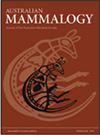Monitoring bent-wing bats at Bat Cleft in Central Queensland
IF 1.2
4区 生物学
Q3 ZOOLOGY
引用次数: 0
Abstract
Undertaking accurate counts is an important part of managing cave-dwelling bats species such as the little bent-wing bat (Miniopterus australis) population at Mt Etna. A thermal camera and automated counting system were trialled to see if the technology would work at Mt Etna with the goal of producing accurate counts of bats. Although the heat radiating from the rock meant that the background at Mt Etna was not perfect, the automated system was able to recognise and count the bats as they emerged. The number of bats emerging from the cave varied from 82 677 in 2017/18 through to 139 783 in 2018/19. These estimates are within the range of those made in the 1960 to 1980s, which suggests that the population is stable, but we are unsure of the accuracy of these previous counts. These results demonstrate that it is possible to obtain accurate counts of reasonably large bat populations such as Bat Cleft and the methodology may have application for other gregarious and nocturnal species whose numbers can be difficult to count at night.昆士兰中部蝙蝠洞的弯翼蝙蝠监测
进行准确的计数是管理洞穴蝙蝠物种的重要组成部分,例如埃特纳山的小弯翼蝙蝠(澳大利亚小翼蝙蝠)种群。测试了一台热像仪和自动计数系统,看看这项技术是否能在埃特纳山发挥作用,目的是准确计数蝙蝠。尽管岩石发出的热量意味着埃特纳山的背景并不完美,但自动化系统能够在蝙蝠出现时识别和计数蝙蝠。从洞穴中出现的蝙蝠数量从82只不等 2017/18年度677至139 783。这些估计在1960年至1980年代的范围内,这表明人口是稳定的,但我们不确定之前这些统计的准确性。这些结果表明,有可能准确地计算出相当大的蝙蝠种群,如蝙蝠叉,该方法可能适用于其他夜间难以计数的群居和夜间物种。
本文章由计算机程序翻译,如有差异,请以英文原文为准。
求助全文
约1分钟内获得全文
求助全文
来源期刊

Australian Mammalogy
ZOOLOGY-
CiteScore
2.50
自引率
8.30%
发文量
26
期刊介绍:
Australian Mammalogy is a major journal for the publication of research in all branches of mammalogy. The journal’s emphasis is on studies relating to Australasian mammals, both native and introduced, and includes marine mammals in the Antarctic region. Subject areas include, but are not limited to: anatomy, behaviour, developmental biology, ecology, evolution, genetics, molecular biology, parasites and diseases of mammals, physiology, reproductive biology, systematics and taxonomy.
Australian Mammalogy is for professional mammalogists, research scientists, resource managers, consulting ecologists, students and amateurs interested in any aspects of the biology and management of mammals.
Australian Mammalogy began publication in 1972 and is published on behalf of the Australian Mammal Society.
 求助内容:
求助内容: 应助结果提醒方式:
应助结果提醒方式:


